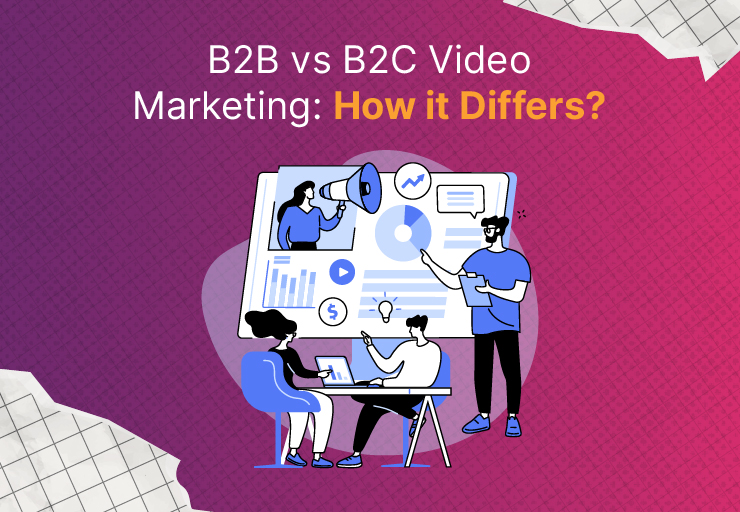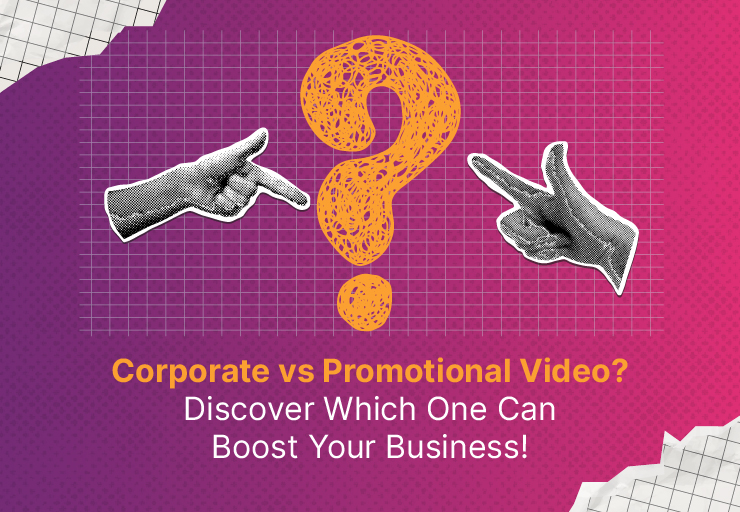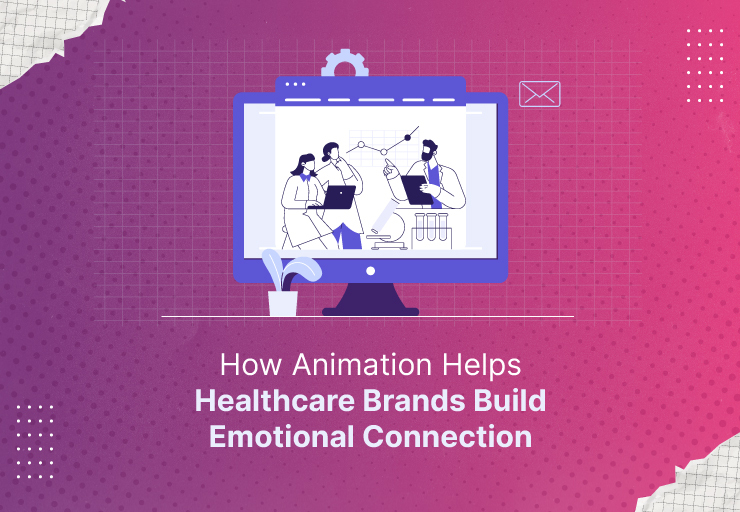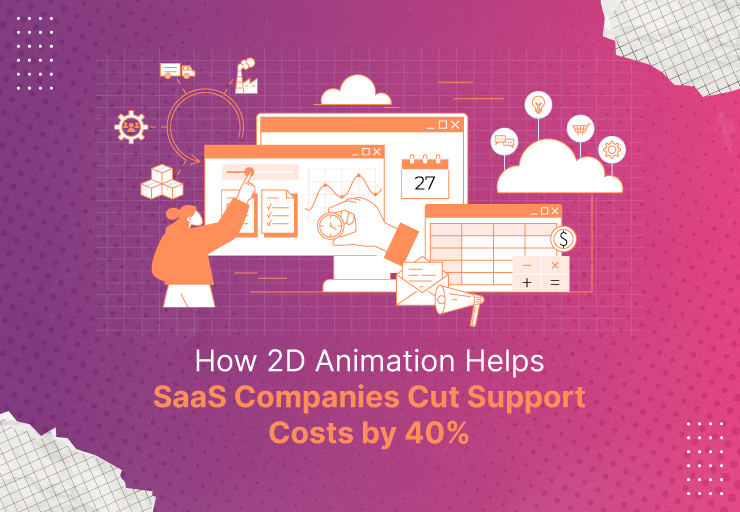
Video marketing is one of the hottest tools you can use to connect with your prospects, build brand visibility, address their pain points, and show why you are the best – in an easy, appealing manner within no time. But, for different types of business, you need other types of videos. And, today we are talking about B2B vs B2C video marketing.
It is different, but B2C and B2B video marketing are two sides of the same coin. While their topics of attention may differ, all formats ultimately have similar goals and can benefit greatly from the evident power of video marketing.
So, depending on your business, recognizing their numerous similarities and variances, and then tailoring your video content to meet each one better, is critical.
In this blog, we will look at the fundamental differences between B2B and B2C video marketing. From target audience to brand positioning, we’ll go over eight characteristics to show how these two approaches differ and intersect at times.
What Is B2C Marketing?
B2C stands for business-to-consumer. B2C video marketing refers to creating content that directly targets individual consumers. The primary goal is to engage, entertain, and persuade consumers to purchase products or services by showcasing benefits that resonate with their needs, desires, and emotions in a simple, relatable, and appealing manner.
- A clothing brand’s Instagram reel showcasing their latest fashion collection with vibrant visuals and trendy music.
- A fitness equipment company’s video ad highlighting quick workouts using their products, emphasizing convenience and health benefits.
- A skincare brand’s tutorial video featuring influencers demonstrating the effectiveness of their products for glowing skin.
By using B2C video marketing, you are speaking directly to individual customers and tapping into their personal motivations. The content needs to create an emotional connection, grab attention quickly, and provide immediate value to the viewer.
What is B2B Marketing?
B2B stands for business-to-business. B2B video marketing refers to other companies as clients. The primary goal is to persuade businesses to purchase products or services that improve their operations by addressing their pain areas and demonstrating how you can assist them in a simple, professional, and timely manner.
- A software company’s video advertisement highlighting how they simplify small business operations
- A video on a marketing agency’s landing page discussing their clients’ sales success
- A cybersecurity firm’s testimonial video featuring a client sharing how the company’s solutions protected their business from data breach
By using B2B video marketing, you are speaking to a company instead of a single consumer. Even if you are first interacting with a single individual, they will frequently seek approval from others. So, your movies should speak to each individual.
However, the recurring theme will be how your organization delivers value to theirs. Therefore, ROI is the ultimate goal of B2B video marketing.
Additional Read:
10 Industries that Need Video Production Services to Level up Their Marketing Strategy
B2B vs B2C Video Marketing
1. Strategic Goals and ROI

Another major contrast between B2B and B2C marketing is the overall goals and ROI of your approach.
The two strategies may have some similarities when it comes to the objectives of video marketing for B2B and B2C companies. Here are some of the common objectives in both B2B and B2C video marketing goals:
- Boost exposure and brand recognition.
- Make appointments and generate leads.
- Encourage conversions for various use cases.
However, when calculating marketing ROI, the two factors diverge significantly.
Revenue and video marketing ROI are closely related to B2B companies. Marketers must link every campaign to a monetary result and discuss how it affects the business’s bottom line.
ROI in B2C video marketing efforts can be measured in a variety of ways, including brand visibility, loyalty enhancement, community development, social proof, and more. It’s not only about income; brands undertake campaigns that target criteria like consideration, loyalty, and brand memory.
2. Brand Positioning

When it comes to brand positioning in B2B video marketing, the focus is usually on being a strategic partner that delivers tangible business value. Through video marketing, you need to highlight unique selling propositions like product efficacy, return on investment, and customization to specific business needs. The content addresses the logical and financial considerations of multiple stakeholders involved in the purchasing decision.
In B2C scenarios, brand positioning centers on differentiating the brand within a competitive consumer market by appealing to desires, needs, or even market trends. Videos often showcase the brand as enhancing the consumer’s lifestyle, providing enjoyment, or fulfilling a specific need. The positioning is crafted to stand out in a crowded marketplace, often leveraging trends, aesthetics, and cultural relevance.
3. Emotional Connect

At first impression, B2B video content appears clinical and data-driven in contrast to B2C’s elegant, lifestyle-focused videos. Surprisingly, however, B2B clients have a closer emotional bond with suppliers than regular consumers.
According to studies, B2B clients are 8 times more inclined to pay a premium for a product or service that provides personal value. Most importantly, though, it should appeal to businesses’ deepest emotional pain areas and explain how your product or service can be a game changer for their business. For instance, a video that explains to them how this will improve the business and make their jobs easier.
B2B purchasers are still human, with complicated emotions that marketing should tap into. However, it also needs to be professional, knowledge-based, and solution-oriented.
B2C consumers, on the other hand, are looking for more than just a trendy product. They look for information that conveys common values to establish a stronger brand relationship.
4. Quality

B2C companies can create quirky, low-budget videos that will still generate the desired results. B2C gives more versatility, and even if your video isn’t of the highest quality, it will work. Nonetheless, it is advised to stay away from shoddy videos. Customers appreciate authenticity to a certain extent, but they ultimately demand a certain level of quality from companies vying for their support.
However, in B2B, poor production might jeopardize the confidence of your prospects in your business. B2B purchasers carefully consider suppliers before settling on spending plans. A video with subpar audio, images, or other components conveys a lack of attention to detail.
And, with B2B video marketing bring your A game because you’re not just persuading individual B2B consumers – you’re appealing to an entire team of decision-makers. And, each one of them has to justify their purchases for the company.
So, when it comes to B2B video marketing, make sure to invest in high-quality products and strategic processes. On the other hand, you can even hire a professional B2B video production company that can help you curate highly professional and high-quality videos.
5. Duration

Another difference between B2B vs B2C video marketing is the duration.
B2C videos are typically shorter. Since you are selling directly to customers, you must communicate more in less time when using B2C videos. They are constantly bombarded with numerous brands fighting for their attention. Therefore, keep your video short (usually between 15 and 30 seconds), and be sure to include the most crucial information at the beginning.
For B2B customers, a little longer video is acceptable. As the purchasing decision is frequently more complicated. Price points are higher, there are more decision-makers engaged, and there are more possible consequences in case of poor judgment. Nevertheless, excellent B2B videos last between 60 and 120 seconds.
While a shorter video can still be successful, the extra time allows you to go into greater detail and give a more convincing argument for why your viewers should support your company.
6. Platforms

One more significant difference? The platform you use to host your video content. There are many amazing platforms available to your business, but they serve very varied purposes depending on the type of client you are aiming to reach.
For consumer-facing material, Vimeo, Instagram, Facebook, TikTok, and YouTube are likely to be the best options. All three platforms offer extensive sharing features that are already social media-optimized, enabling you to connect with a broad prospect base.
For B2B, LinkedIn, Slideshare, Twitter, and Vidyard are platforms that come preloaded with a large number of business experts that your company may reach out to. Even B2B can list their videos on their website that guide the website visitors and even boost the SERP rankings, as websites with videos encourage visitors to stay more and take action that boosts rankings, visibility, and even sales.
Nonetheless, even B2B are benefitting from video marketing by sharing their videos on Instagram, Facebook, and related platforms.
7. Marketing Funnel

The marketing funnel guides purchasers through each stage of the purchasing process until they become paying clients. The B2B marketing funnel is long and complex. A normal sales cycle can extend up to six months because a buying group involves several parties, and the funnel has numerous stages.
So, B2B companies can create videos with case studies, product demos, and webinars that are particularly effective for B2B audiences as they provide in-depth insights and address specific pain points(effectively).
The B2C marketing funnel, on the other hand, has fewer touchpoints and is shorter. By creating amusing and captivating videos that provide exclusive offers, influencer endorsements, immediate advantages, and other content, brands can capture viewers’ attention and persuade them to buy. B2C purchasers typically make all of the decisions, therefore the purchasing process is faster and has fewer steps.
8. Content

In B2C video marketing, you can go above and above to capture the attention of the consumer by creating interesting content. The primary goal of B2C video marketing is to keep your target audience interested and engaged, which you can fulfill by producing amusing and lighthearted content.
We’re not saying that business-to-business video doesn’t have to be interesting. Instagram reels, for instance, are becoming increasingly popular among B2B organizations as a way to combine entertaining and educational information.
However, videos in B2B marketing are typically focused on the company, its product/service, benefits, and so on. In B2B video marketing, the emphasis is on the products, advantages, and financial factors. However, the content is more professional than enjoyable. Your content strategy must center on these principles, and video content must successfully convey the message.
To Sum It All!
At the end of the day, whether you’re doing B2B or B2C video marketing, it’s all about connecting with your audience—just in different ways. B2B video marketing is more about building trust, showing your expertise, and offering solid solutions that make a business’s life easier.
On the flip side, B2C is all about creating that instant emotional spark. It’s fast-paced, fun, and focused on how your product or service fits into someone’s lifestyle, making them feel like they need it.
While both B2B and B2C video marketing have similar goals—the approach and tone are what set them apart. If you nail the right strategy for your audience, you’ll be well on your way to making a lasting impact.
If you would like to get things off to a good start(whether B2B or B2C video marketing), Krisha Studio can help you out. You can book a free consultation call to learn how can help.




